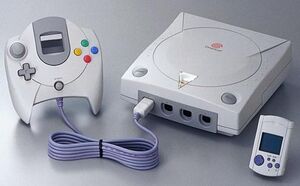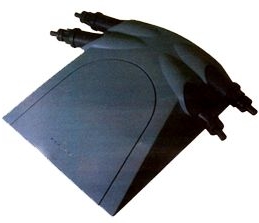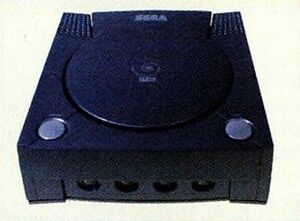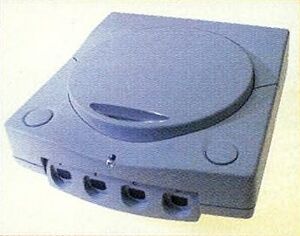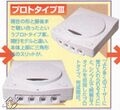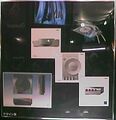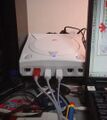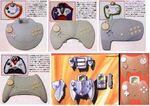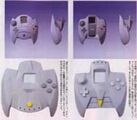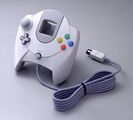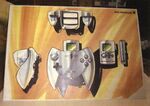Difference between revisions of "History of the Sega Dreamcast"
From Sega Retro
m (Black Squirrel moved page Sega Dreamcast Development to Dreamcast development) |
m (Text replacement - "nVidia" to "NVIDIA") |
||
| Line 16: | Line 16: | ||
Doubts began to be cast towards the end of the year, due to Sega's increased frustrations with Lockheed Martin, who were simultaneously working on the [[Sega Model 3]] arcade platform. The Model 3, once set for release in late 1995, wasn't due to be seen until mid-1996, causing Sega to temporarily lose its competitive edge in the arcades. | Doubts began to be cast towards the end of the year, due to Sega's increased frustrations with Lockheed Martin, who were simultaneously working on the [[Sega Model 3]] arcade platform. The Model 3, once set for release in late 1995, wasn't due to be seen until mid-1996, causing Sega to temporarily lose its competitive edge in the arcades. | ||
| − | At this time, Sega parntered with the rising graphics company, | + | At this time, Sega parntered with the rising graphics company, NVIDIA, who based their first video card, the [[NV1]] off the Sega Saturn hardware (even allowing for Saturn controllers to be plugged in via a second board). NVIDIA had a hard time persuading Sega that the technology was the future, however - Sega were already sceptical due to the PlayStation's early success, and even though Sega converted several Saturn games to benefit from the NV1, sales of the video card were poor. NVIDIA reportedly started to work on a successor, the NV2 but the project was shelved. Had it been finalised, the technology behind the NV2 would likely have likely replaced the R3D/100 graphics chipset for Sega's next console. |
===1996=== | ===1996=== | ||
Revision as of 06:24, 14 June 2015
| This article needs cleanup. This article needs to be edited to conform to a higher standard of article quality. After the article has been cleaned up, you may remove this message. For help, see the How to Edit a Page article. |
The Sega Dreamcast was perhaps the first video game console whose development cycle was watched and scrutinised by the video game world. The development of previous consoles were largely kept under wraps by their developers, with only industry specialists knowing what was in the pipeline in terms of new hardware.
In the past, most of the discussion in regards to new video game consoles was done in magazines (particularly officially licensed ones which had access to exclusive material from the manufacturer), however the Dreamcast entered into production at a time where consumers were hooking up to the internet, meaning information was spread like never before. As a result we have a much clearer understanding of how the Dreamcast was built than with previous Sega consoles.
Contents
Rough Timeline of Events
1994
Such was the state at Sega at the time, a successor to the Sega Saturn was considered even before the console had been released. After a series of talks with Nintendo for a CD-based add-on for the Super Nintendo console broke down, Sony unveiled their stand-alone PlayStation system in November 1993, rattling Sega's management considerably. Sega had not seen Sony as a threat until this point, worried instead of what Nintendo may have had in-store with their presumed successor to the Super Nintendo. The Saturn, at the time built primarily to tackle 2D gaming, simply could not compete with Sony's hardware from a technical perspective, and a series of rash decisions were made to attempt to make the Saturn more competitive at launch.
During 1994 three possible options crossed CEO Hayao Nakayama's path. Either to press on with the Saturn project as is, upgrade it, or scrap the Saturn project entirely in favour of another, superior console. Rumours of a "Saturn 2" console appeared as early as September 1994, with talks that the Saturn 2 could be sold as an add-on (similar to the Sega 32X) or replace the original Saturn within one or two years. Ultimately the decision was made to enhance the Saturn, and with the help of Hitachi, extra processors were added to make the console more powerful than the PlayStation. Unfortunately this came at a price, and the added complexities of this rushed design meant very few programmers could tap in to the Saturn's true potential.
1995
Though the Saturn was selling fairly strongly in Japan during 1995, talks of the Saturn 2 were still on the table as developers across the world were becoming ever more displeased with Sega's recent offering. It emerged in 1995 that the Saturn 2 project was no longer in the exclusive hands of Sega - Lockheed Martin, who had assisted the company with the graphics powering the Sega Model 1 and Sega Model 2 arcade boards, were now in charge of the Saturn 2 project, with a focus primarily on graphical power.
At the time, Lockheed Martin were working on their "Real3D" series of chipsets for Windows-based PCs, and the Saturn 2 was rumoured to use the R3D/100 chipset as a base for its graphics. PC graphics were not yet "standardised" at this time - DirectX had yet to be invented and though Lockheed Martin were working with the now widely used OpenGL technology, there were a vast array of competing video cards on the market.
Doubts began to be cast towards the end of the year, due to Sega's increased frustrations with Lockheed Martin, who were simultaneously working on the Sega Model 3 arcade platform. The Model 3, once set for release in late 1995, wasn't due to be seen until mid-1996, causing Sega to temporarily lose its competitive edge in the arcades.
At this time, Sega parntered with the rising graphics company, NVIDIA, who based their first video card, the NV1 off the Sega Saturn hardware (even allowing for Saturn controllers to be plugged in via a second board). NVIDIA had a hard time persuading Sega that the technology was the future, however - Sega were already sceptical due to the PlayStation's early success, and even though Sega converted several Saturn games to benefit from the NV1, sales of the video card were poor. NVIDIA reportedly started to work on a successor, the NV2 but the project was shelved. Had it been finalised, the technology behind the NV2 would likely have likely replaced the R3D/100 graphics chipset for Sega's next console.
1996
It has been rumoured that Sega made a fairly bold decision in early-1996, almost abandoning their Model 3 platform entirely. At the time, rival 3DO was producing its own arcade platform, the M2, and Sega decided to order some development kits in a deal which would see them provide the system exclusively with games. Inevitably a mixture of egos and reports of poor performance led to Sega abandoning the M2 project shortly afterwards, and eventually the Sega Model 3 board was finalised and put to market. The Model 3 would be Sega's last deal with Lockheed Martin - the two companies would go their separate ways shortly afterwards, and Lockheed Martin's "Saturn 2" project was effectively scrapped.
Nintendo's new console, the Nintendo 64 was released in 1996 putting even more pressure on Sega to act. Though the Saturn sold consistently well in Japan, it was being hammered in the western world. The PC market was continuing to evolve, being dominated by two graphics standards - the PowerVR series by VideoLogic, and the Voodoo cards by 3Dfx. Sega chose to approach both companies in 1996, effectively starting two "Saturn 2" projects which would work in parallel until mid-1997.
VideoLogic's attempt would be named "Dural" (named after a character from Sega AM2's Virtua Fighter series), with development occuring in Japan, while 3Dfx's project would be named "Black Belt", with work being undertaken in the US.
1997
Sega were said to be actively seeking partnerships in 1997, though there was still much uncertainty in regards to the details. Talks began with Microsoft for undisclosed reasons, and work continued on both Saturn 2 projects.
3Dfx's Black Belt project was the subject of widespread speculation, as by this point, 3Dfx were leading the PC video card market. 1997 was also the year when Shoichiro Irimajiri came to office, and having assessed the situation decided to hire Tatsuo Yamamoto, a former IBM engineer, to work on the Black Belt project. Hideki Sato, however, got wind of this idea, and joined the Dural project (now called "Katana") with his team.
It was also announced in 1997 that Hitachi would be making the CPU for the Katana machine, a company who had already played a role in the Sega 32X and Sega Saturn's development. Hideki Sato and his group had chosen to use the Hitachi SH4 processor architecture (codenamed "White Belt") and were using NEC/Videologic's PowerVR Series II (codenamed "Guppy") graphics chips in the production of their main board.
Conversely, Yamamoto and his group opted to use 3DFX's Voodoo 2 and Voodoo Banshee graphics processors, and after initially trying other RISC processors from IBM and Motorola, settled on the SH4 as well. At one stage the Black Belt, jointly developed by SegaSoft, Microsoft and 3DFX, was shown to a limited number of developers and was apparently very well received. The OS was designed to make the machine easy to develop for and allowed for quick conversions of games to and from the PC. At the time Sega's policy seemed to suggest that raw processing power wasn't as important as an easy to develop for operating system - the Saturn reportedly was very difficult for developers to use, and it seemed logical to rectify this.
Furthermore the Black Belt project was backed by newly recruited Sega of America COO, Bernie Stolar, who had already began to attempt to discontinue the struggling Sega Saturn in the region, even going as far to claim the system was "not our future" at that year's E3.
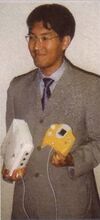
Initially, Sega decided to use Yamamoto's design and suggested to 3Dfx that they would be using their hardware in the upcoming console, but a change of heart caused them to use Sato's PowerVR-based design instead. There are conflicting reports claiming whether the "Katana" was more powerful than the "Blackbelt" or vice versa - Sonic Team and Dreamcast developer Yuji Naka was caught in 1998 stating that ports of Sonic Adventure to the PC was impossible, because 3DFX's Voodoo cards were significantly less powerful than what was in the Katana-based Dreamcast. It was also suggested that the Black Belt would cost more to produce and deliver less, making it uncompetitive.
The choice to go for the Katana project puzzled Electronic Arts, a longtime developer for Sega's consoles. EA had invested in the 3Dfx company and were unaware of VideoLogic's creations, and this difference of opinion, as well as poor Saturn sales, may have attributed to why the publisher refused to back the Dreamcast in its final iteration.
Sega's decision has also been attributed to 3Dfx leaking details and technical specifications of the then-secret Dreamcast project when declaring their Initial Public Offering in June 1997. In response, 3Dfx filed a $155 million USD lawsuit in September against Sega and NEC, claiming that they had been misled into believing that their technology would be used when in fact a back-room deal had been done between the two Japanese companies in the months prior to the announcement. They also claimed that Sega deprived 3Dfx of confidential materials in regards to 3Dfx's intellectual property.
The lawsuit was settled in August 1998, with Sega paying USD $10.5 million to 3Dfx. Sega made massive losses around this period, with many staff layoffs making the news.
1998
In early 1998 it was confirmed that the PowerVR Series II was chosen for the Katana, but there were also reports that the Black Belt project had not gone entirely to waste - the Katana's operating system had been tweaked to make it just as easy to use and develop for as the American system.
It seemed as if Microsoft no longer had a role in the console's development, however 1998 was also the period where they announced another operating system was available to Katana users - one based on its Windows CE technologies. Initially it was thought the Dreamcast could be bridging the gap between home PCs and video game consoles, however this was revealed not to be the case. Windows CE was intended to attract developers from Windows 95/98, presenting a less daunting development environment for those who had not worked on consoles before.
Microsoft decided to cooperate with Sega in an attempt to promote its Windows CE operating system for video games, but Windows CE for the Dreamcast showed very limited capabilities when compared to the Dreamcast's native operating system. The libraries that Sega offered gave room for much more performance, but they were sometimes more difficult to utilize when porting over existing PC applications. Numerous Sega executives have gone on record stating that they felt the native OS was faster and more powerful.
There were also troubles with Electronic Arts. Sega's financial position meant they were unable to offer the same generous offers which kept the company by their side in previous generations.
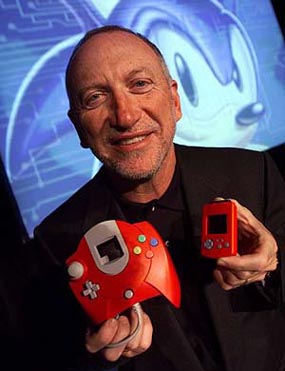
Then-CEO of EA, Larry Probst (a friend of Bernie Stolar) allegedly put forward a deal which only saw EA sports games being released on the Dreamcast platform for five years, potentially leading to market dominance. Sega could not meet the terms of this agreement, and neither did they appear to want to - Visual Concepts was bought by Sega for USD $10 million and the widely held view was that their next NFL game (NFL 2K) would out-perform the likes of Madden 2000. Sega attempted to get a better offer for them, but EA would not budge, leading to a Dreamcast without any support from the company at all.
In May 1998 the Dreamcast console was shown to the world for the first time, with the intention of being released in Japan in November 1998. Sega's tactics were unusual for Japan - the Dreamcast would be supported along with the Saturn, primarily handling 3D titles. The Saturn would do 2D, however the move to announce the Dreamcast was seen by many Japanese developers as unnecessary solely because the Saturn was holding its ground quite nicely. Sega had expected a PlayStation 2 to be released in late 1999 (it was actually early 2000) and wanted to build up a year's worth of titles in advance to stall Sony's efforts. Similarly, delays in western regions were put in place to give the console a strong launch lineup.
By mid-1998 the internals of the Dreamcast had been finalised, though a final colour had not yet been chosen. Red and yellow prototype Dreamcasts were spotted in this year.
1999
Though the Dreamcast console was already out in Japan, it had not yet seen the light of day in North America or Europe. It is said that Bernie Stolar went against his Japanese superiors by pricing the Dreamcast with a launch price of USD $199 (which he unveiled in a speech in early 1999, to standing ovation). Reportedly, Sega Japan wanted to price the DC at USD $249 in order to be very profitable right from the start. Stolar was fired before the Dreamcast's launch.
Issues were also raised with the PAL variant of the Dreamcast console. Its logo was feared to infringe trademarks with German publisher, Tivola. This is why PAL logos are blue.
Console
Main aims of the Dreamcast console appear to have been a disc-based console with better 3D graphics rendering capabilities than the Sony PlayStation (and presumably Nintendo 64). Perhaps most importantly was the Dreamcast's built-in modem, which appears to have been outlined at a very early stage. This is despite the commonly held belief at the time that the internet could not yet yield profits for those in the video game industry - the primary reason, in fact, that the PlayStation 2, GameCube and Xbox lack the same extent of internet support as the Dreamcast.
"Bread Bin" Design
Though most prototype designs were confined to the drawing board, Sega produced a few physical prototypes, the most radical is this "wedge" or "bread bin" design, unlike any video game console released before or since. This is apparently cited as being the "first" prototype, or at least, earlier than the two which follow.
It appears to sport four controller "ports" and has a lid, where presumably games would be inserted. It is grey and lacks names or logos.
"Black Box"
The second design is far more similar to the final product, though seems to be taking design lessons from the western Sega Saturn. The four controller ports are now housed at the front, similar to the Nintendo 64, and there are two buttons, one to presumably open the lid, and another to turn the unit on. It is clear from this stage that the reset button of the Saturn would not be included in the Dreamcast.
It is possible that this is the BlackBelt design, for it is quite literally black.
"White Box"
The third iteration is far more similar to the final product. It is now white, has a power LED and a window to see the disc spinning (which would be omitted from the final design).
Others
Controller
The Dreamcast controller was derived from the Sega Saturn's 3D Control Pad. Every prototype Dreamcast controller acknowledges the need for an analogue stick.
Air NiGHTS Controller
Yuji Naka was involved in the Dreamcast project during its conception, though inevitably got caught up in Sonic Adventure's development towards the end. It is rumoured, however, that the NiGHTS into Dreams team influenced a design of the Dreamcast controller - one built like a remote and with motion sensors, almost a decade before the Wii entered the market. It was to be used in conjunction with the Air NiGHTS project.
Visual Memory Unit
Early VMU designs looked similar, if not more colorful, than the final product.
Tech Demos
Shoichiro Irimajiri's Head
http://www.youtube.com/watch?v=-Lt1o7nwU8M
When the Dreamcast was introduced to the world on the 21st of May, 1998, it was paired with a tech demo showing the head of then-CEO of Sega, Shoichiro Irimajiri floating about a screen supposely being rendered in real-time (similar to the introduction of Super Mario 64). Irimajiri's head movements were said to have been mapped onto a 3D model for use in this demo. Demonstrated are particle and rendering effects.
Scud Race
http://www.youtube.com/watch?v=irUqYGF0AG0
Also available to see was a Dreamcast rendering of Scud Race - a game previously released for Sega Model 3 hardware but skipped home consoles entirely.
Tower of Babel
http://www.youtube.com/watch?v=f9b3mcX_cdM
Supposedly cooked up by three developers in ten days, Tower of Babel demonstrates the Dreamcast's ability to render large environments. It is rumoured this technology went into Shenmue.
HKT-01 Demos
http://www.youtube.com/watch?v=mpZxsuOMt3E http://www.youtube.com/watch?v=mkPCzDn2j1o
Various demos can be found in Dreamcast development kits, including more of Scud Race, the FMV introduction of Sonic 3D: Flickies' Island, the infamous teapot often used for graphical tests, etc.

